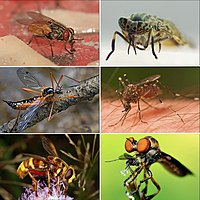
Photo from wikipedia
Salticidae is the most species-rich family of spiders with diverse morphology, ecology and behavior. However, the characteristics of the mitogenomes within this group are poorly understood with relatively few well-characterized… Click to show full abstract
Salticidae is the most species-rich family of spiders with diverse morphology, ecology and behavior. However, the characteristics of the mitogenomes within this group are poorly understood with relatively few well-characterized complete mitochondrial genomes. In this study, we provide completely annotated mitogenomes for Corythalia opima and Parabathippus shelfordi, which represent the first complete mitogenomes of the tribe Euophryini of Salticidae. The features and characteristics of the mitochondrial genomes are elucidated for Salticidae by thoroughly comparing the known well-characterized mitogenomes. The gene rearrangement between trnL2 and trnN was found in two jumping spider species, Corythalia opima and Heliophanus lineiventris Simon, 1868. Additionally, the rearrangement of nad1 to between trnE and trnF found in Asemonea sichuanensis Song & Chai, 1992 is the first protein-coding gene rearrangement in Salticidae, which may have an important phylogenetic implication for the family. Tandem repeats of various copy numbers and lengths were discovered in three jumping spider species. The codon usage analyses showed that the evolution of codon usage bias in salticid mitogenomes was affected by both selection and mutational pressure, but selection may have played a more important role. The phylogenetic analyses provided insight into the taxonomy of Colopsus longipalpis (Żabka, 1985). The data presented in this study will improve our understanding of the evolution of mitochondrial genomes within Salticidae.
Journal Title: Insects
Year Published: 2023
Link to full text (if available)
Share on Social Media: Sign Up to like & get
recommendations!